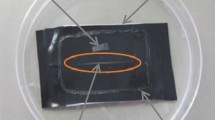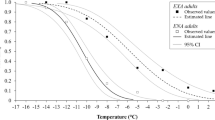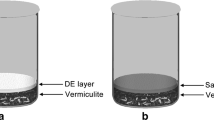Abstract
Water maintenance is vital for termite survival under dry conditions, hence environment humidity is one of the most important factors that controls the distribution of Isoptera. To understand the dynamics of termite rehydration after water loss, two bioassays were performed with forager workers of Coptotermes gestroi (Wasmann) submitted to water stress. Insects were weighed and placed into Petri dishes without water and food for periods of 3, 15, and 30 h. For each period of water stress, 10 replicates were performed in the treatment and control groups, totalling 120 experimental units. Forager workers lost body mass across all periods of water stress and tested with the highest reduction for the 30 h exposure period. Subsequent access to water resulted in termite rehydration, and final weight values were near to initial body mass values. These results demonstrate that workers of C. gestroi experienced large reductions of body mass under water stress, but these reductions were not severe enough to cause mortality. Additionally, termites were able to rehydrate after water stress conditions. This is a potential risk factor to be considered in cases of new infestations because C. gestroi workers will be able to cause economic damage in their new locations even when deprived of water during their transportation by humans.


Similar content being viewed by others
References
Arab A, Costa-Leonardo AM (2005) Effect of biotic and abiotic factors on the tunnelling behaviour of Coptotermes gestroi and Heterotermes tenuis (Isoptera: Rhinotermitidae). Behav Process 70:3240
Araujo RL (1970) Termites of the Neotropical region. In: Krishna K, Weesner FM (eds) Biology of termites, vol 2. Academic, NY and London, pp 527–576
Ayres M, Ayres M Jr, Ayres DL, Santos AAS (2007) BioEstat 5.0: aplicações estatísticas nas áreas das ciências biológicas e médicas. Sociedade Civil Mamirauá, Belém - PA, p 364
Chapman RF (1998) The insects: structure and function. Cambridge, Cambridge University Press, p 770
Collins MS (1969) Water relations in termites. In: Krishna K, Weesner FM (eds) Biology of termites, vol 1. Academic, NY and London, pp 433–458
Collins MS, Richards GA (1963) Studies on water relations in North American termites. I Eastern species of the genus Reticulitermes (Isoptera: Rhinotermitidae). Ecology 44:600–604
Constantino R (1998) Catalog of the living termites of the new world (Insecta: Isoptera). Arq Zool 325:135–230
Constantino R (2002) The pest termites of South America: taxonomy, distribution and status. J Appl Entomol 126:355–365
Costa-Leonardo AM (2002) Cupins-praga: morfologia, biologia e controle. A.M. Costa-Leonardo (ed.), Rio Claro-SP, p 128
Costa-Leonardo AM, Barsotti RC, Camargo-Dietrich CRR (1999) Review and update on the biology of Coptotermes havilandi (Isoptera, Rhinotermitidae). Sociobiology 33:339–356
Delaplane KS, La Fage JP (1989) Preference for moist wood by the Formosan subterranean termite (Isoptera: Rhinotermitidae). J Econ Entomol 82:95–100
Evans TA, Forschler BT, Grace JK (2013) Biology of invasive termites: a worldwide review. Annu Rev Entomol 58:455–474
Gallagher NT, Jones SC (2010) Moisture augmentation of food items by Reticulitermes flavipes (Isoptera: Rhinotermitidae). Sociobiology 55:735–747
Gold RE, Jones SC (2000) Handbook of household and structural insect pests. Entomological Society of America, Lanham, p 154
Grube S, Rudolph D (1999) The labial gland reservoirs (water sacs) in Reticulitermes santonensis (Isoptera: Rhinotermitidae): studies of the functional aspects during microclimatic moisture regulation and individual water balance. Sociobiology 33:307–323
Grube S, Rudolph D, Zerbst-Boroffka I (1997) Morphology, fine structure, and functional aspects of the labial glands of the subterranean termite Reticulitermes santonensis De Feytaud (Isoptera: Rhinotermitidae). Int J Insect Morphol 26:49–53
Haagsma KA, Nguyen J, Rust MK (1996) A new model describing the weight to surface area relationship of termites (Isoptera). Sociobiology 28:28–44
Hadley NF (1994) Water relations of terrestrial arthropods. Academic Press, San Diego, p 356
Hewitt PH, Nel JJC, Schoeman I (1971) Influence of group size on water imbibition by Hodotermes mossambicus alate termites. J Insect Physiol 17:587–600
Hu J, Neoh KB, Appel AG, Lee CY (2012) Subterranean termite open-air foraging and tolerance to desiccation: comparative water relation of two sympatric Macrotermes spp. (Blattodea: Termitidae). Comp Biochem Physiol A 161:201–207
Krecek J (1969) Effect of relative humidity of air and of starvation on survival in five termite species from Cuba. Acta Entomol Bohemoslov 366:129–136
Lepage M, Darlington JPEC (2000) Population dynamics of termites. In: Abe T, Bignell DE, Higashi M (eds) Termites: evolution, sociality, symbioses, ecology. Kluwer, Dordrecht, pp 333–361
Lys JA, Leuthold RH (1994) Forces affecting water imbibition in Macrotermes workers (Termitidae: Isoptera). Insect Soc 41:79–84
McManamy K, Koehler PG, Branscome DD, Pereira RM (2008) Wood moisture content affects the survival of eastern subterranean termites (Isoptera: Rhinotermitidae), under saturated relative humidity conditions. Sociobiology 52:145–156
Noirot C (1970) The nests of termites. In: Krishna D, Weesner FM (eds) Biology of termites, vol 2. Academic, NY and London, pp 73–125
Noirot C, Noirot-Timothhe C (1966) Revêtement de la membrane cytoplasmique et absorption des ions dans les papilles rectales d’un termite (Insecta, Isoptera). Compt Rend D263:1099–1102
Rudolph D, Glocke B, Rathenow S (1990) On the role of different humidity parameters for the survival, distribution and ecology of various termite species. Sociobiology 17:129–140
Ruppert EE, Fox RS, Barnes RD (2005) Zoologia dos invertebrados. 7ª Ed. Tradução de 356 P.M. Oliveira, São Paulo, SP, Ed. Roca, p 1028
Shelton TG, Grace JK (2003) Cuticular permeability of two species of Coptotermes Wasmann (Isoptera: Rhinotermitidae). Comp Biochem Physiol A 134:207–213
Sieber R, Kokwaro ED (1982) Water intake by the termite Macrotermes michaelseni. Entomol Exp Appl 31:147–153
Sponsler RC, Appel AG (1990) Aspects of the water relations of the Formosan and eastern subterranean termites (Isoptera: Rhinotermitidae). Environ Entomol 19:15–20
Strickland M (1950) Differences in toleration of drying between species of termites (Reticulitermes). Ecology 51:373–385
Watson JAL, Hewitt PH, Nel JJC (1971) The water-sacs of Hodotermes mossambicus. J Insect Physiol 17:1705–1709
Wong N, Lee C-Y (2010) Influence of different substrate moistures on wood consumption and movement patterns of Microcerotermes crassus and Coptotermes gestroi (Blattodea: Termitidae, Rhinotermitidae). J Econ Entomol 103:437–442
Acknowledgments
The authors thank to CNPq (Conselho Nacional de Desenvolvimento Científico e Tecnológico) and to CAPES (Coordenação de Aperfeiçoamento de Pessoal de Nível Superior) for financial support on their termite research.
Author information
Authors and Affiliations
Corresponding author
Additional information
Edited by Jorge B Torres – UFRPE
Rights and permissions
About this article
Cite this article
Janei, V., Lima, J.T. & Costa-Leonardo, A.M. Rehydration After Water Stress in Forager Workers of Coptotermes gestroi (Wasmann) (Blattaria: Rhinotermitidae). Neotrop Entomol 44, 301–307 (2015). https://doi.org/10.1007/s13744-015-0285-6
Received:
Accepted:
Published:
Issue Date:
DOI: https://doi.org/10.1007/s13744-015-0285-6




